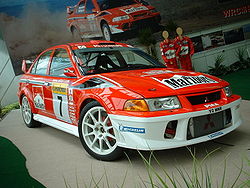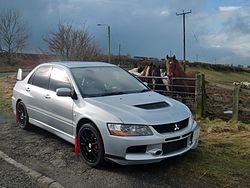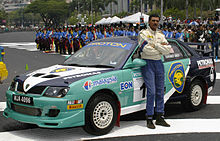- Mitsubishi Lancer Evolution
-
Mitsubishi Lancer Evolution 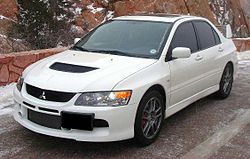
Manufacturer Mitsubishi Motors Production 1992–present Assembly Mizushima Plant, Kurashiki, Okayama Class Sport compact
World Rally Car
Sports sedanBody style 4-door sedan
5-door wagon (Evo IX, 2007)Layout Front engine, four-wheel drive Engine 2.0 L I4 turbo
4G63T (1987–2007)
4B11T (2008–present)Related Mitsubishi Lancer
Mitsubishi Lancer WRC
Mitsubishi Racing LancerThe Mitsubishi Lancer Evolution, colloquially known as the Lancer Evo or Evo,[1] is a high-performance sedan manufactured by Mitsubishi Motors. There have been ten official versions to date, and the designation of each model is most commonly a roman numeral. All use two litre, turbocharged engines and four-wheel drive systems.[2]
The Evolution was originally intended only for Japanese markets, but demand on the "grey import" market led the Evolution series to be offered through Ralliart dealer networks in the United Kingdom and in various European markets from around 1998. Mitsubishi decided to export the eighth generation Evolution to the United States in 2003 after witnessing the success Subaru had in that market with their Impreza WRX, a direct competitor in other global regions.[3] A re-badged version of the car has appeared in Malaysian markets as the Proton PERT, alongside Proton range of modified Lancers under the Proton Wira nameplate.
Japanese-spec cars were limited by a gentlemen's agreement to advertise no more than 280 PS (206 kW; 276 hp), a mark already reached by Evolution IV. Therefore, each subsequent version has unofficially evolved above the advertised power figures, with the Japanese-spec Evolution IX reaching an alleged output of around 321 PS (236 kW; 317 hp). Various versions available in other markets, particularly the UK, have official power outputs up to 411 PS (302 kW; 405 hp).
The tenth generation of the Lancer Evolution was launched in Japan 2007, and overseas markets in 2008.
Contents
Evolution I
First generation 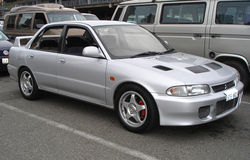
Production October 1992 – January 1994 Platform CD9A Transmission 5-speed manual Wheelbase 2,500 mm (98.4 in) Length 4,310 mm (169.7 in) Width 1,695 mm (66.7 in) Height 1,395 mm (54.9 in) Curb weight 1,170–1,240 kg (2,579–2,734 lb) The original Lancer Evolution was to compete in the World Rally Championship. It used the 2.0 L twin turbocharged DOHC engine and 4WD drivetrain from the original Galant VR-4 in a Lancer chassis, and was sold in GSR and RS models. This engine was also used in the Mitsubishi RVR with the Hyper Sports Gear trim package. The RS was a stripped-down club racing version that lacked power windows and seats, anti-lock brakes, a rear wiper, and had steel wheels to weigh approximately 70 kg (154 lb) less than the 1,238 kg (2,729 lb) GSR, while the former came with all of the conveniences of a typical street car. It came with Mitsubishi's 4G63 engine producing 247 PS (182 kW; 244 hp) at 6000 rpm and 309 N·m (228 lb·ft) at 3000 rpm. 5,000 of the first generation Evolutions were sold between 1992 and 1993. Top speed is 228 km/hour (142 mph)
Evolution II
Second Generation 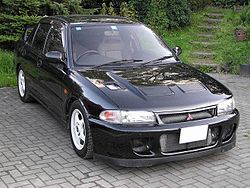
Production January 1994 – February 1995 Platform CE9A Transmission 5-speed manual Wheelbase 2,510 mm (98.8 in) Length 4,310 mm (169.7 in) Width 1,695 mm (66.7 in) Height 1,420 mm (55.9 in) Curb weight 1,180–1,250 kg (2,601–2,756 lb) The Evolution II was upgraded in December 1993, and was produced until February 1995. It consisted mainly of handling improvements, including minor wheelbase adjustments, larger swaybars, bodywork tweaks including a larger spoiler, and tyres that were 10 mm (0.4 in) wider. This Evolution also has a 50 l (13.2 US gal; 11.0 imp gal) fuel tank. Power output was increased to 256 PS (188 kW; 252 hp) from the same engine and torque was unchanged for both GSR and RS models.
Evolution III
Third generation 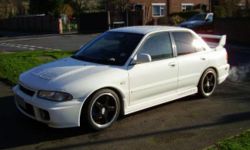
Production February 1995 – August 1996 Platform CE9A Transmission 5-speed manual Wheelbase 2,510 mm (98.8 in) Length 4,310 mm (169.7 in) Width 1,695 mm (66.7 in) Height 1,420 mm (55.9 in) Curb weight 1,190–1,260 kg (2,624–2,778 lb) February 1995 saw the arrival of the Evolution 3, which had several improvements over the previous models. New, more aggressive styling and a new nose moulding improved the air supply to the radiator, intercooler and brakes. New side skirts and rear bumper moldings and a larger rear spoiler were added to reduce lift. Improved engine had higher compression ratio than before,[4] and new turbocharger compressor (60 mm to 68 mm[5]), which gave power output of 270 bhp (201 kW) at 6250 rpm, 309 N·m (228 lb·ft) at 3000 rpm.
Evolution IV
Fourth generation 
Production August 1996 – January 1998 Platform CN9A Transmission 5-speed manual Wheelbase 2,510 mm (98.8 in) Length 4,330 mm (170.5 in) Width 1,690 mm (66.5 in) Height 1,415 mm (55.7 in) Curb weight 1,260–1,350 kg (2,778–2,976 lb) The Lancer platform was completely changed in 1996, and along with it the Evolution, which had become extremely popular throughout the world. The engine and transaxle was rotated 180° to better balance the weight and eliminate torque steer. There were two versions available, The RS and GSR. The RS version was produced as a competition car with a limited-slip front differential and a friction type LSD at the rear. It also came with GLX seats and a choice of either 16" or 17" OZ light weight racing wheels. The RS also had wind up windows, optional air conditioning in some models, and a few extra brace bars to strengthen the chassis, one behind the front grill and the other across the boot floor. The RS also had thinner body panels and glass. The GSR and the RS shared a new twin scroll turbocharger which helped to increase power to 280 PS (206 kW; 276 hp) at 6,500 rpm and 330 N·m (243 lb·ft) of torque at 4,000 rpm. Mitsubishi's new Active Yaw Control appeared as a factory option on the GSR model, which used steering, throttle input sensors and g sensors to computer-hydraulically control torque split individually to the rear wheels and as a result the 10000 Evolution IVs produced all sold quickly. The Evolution IV can be distinguished by its two large fog lights in the front bumper (option on RS version), and the newly designed tail lights on the rear, which became a standard design to Evolution V, which would become yet another trademark of the Evolution series. This new generation was slightly heavier than previous Evos—the GSR in particular due to the added technology systems—but to counter this the car produced even more power—the weight of the RS being 1,260 kg (2,778 lb) and the GSR being 1,345 kg (2,965 lb). Much of the technical improvements for this generation were also used in the second generation Mitsubishi RVR sold only in Japan.
Evolution V
Fifth Generation 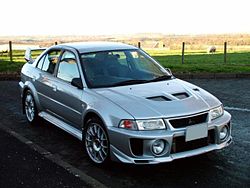
Production 1998 Platform CP9A Transmission 5-speed manual Wheelbase 2,510 mm (98.8 in) Length 4,350 mm (171.3 in) Width 1,770 mm (69.7 in) Height 1,405–1,415 mm (55.3–55.7 in) Curb weight 1,260–1,360 kg (2,778–2,998 lb) Many aspects of the car were changed such as:
- The interior was upgraded in the GSR version with a better class of Recaro seat.
- The body kit had flared arches at the front and rear and a new aluminium rear spoiler replaced the IV FRP version and gave an adjustable angle of attack to alter rear down force.
- The track was widened by 10 mm (0.4 in), the wheel offset changed from ET45 to ET38 along with the wheel diameter which rose from 16" to 17" to accommodate Brembo brakes which were added to enhance braking.
- In addition the brake master cylinder bore increased by 0.3 millimetres (0.01 in).
- The engine was strengthened in a few areas and the cam duration was increased. The pistons were lighter with a smaller skirt area. 510 cc injectors were replaced with 560 cc injectors for better engine reliability due to more electrical "headroom" and the ECU was changed to include a flash ROM, allowing more boost pressure to the same TD05-HR as the Mitsubishi Evolution III and IV.
Furthermore, the turbocharger was again improved. Torque was increased to 373 N·m (275 lb·ft) at 3000 rpm. Power officially stayed the same, at 280 PS (206 kW; 276 hp), though some claim horsepower was actually somewhat higher.
Evolution VI
Sixth generation Production January 1999 – March 2001 Platform CP9A Transmission 5-speed manual Wheelbase 2,510 mm (98.8 in) Length 4,350 mm (171.3 in) Width 1,770 mm (69.7 in) Height 1,405–1,415 mm (55.3–55.7 in) Curb weight 1,260–1,360 kg (2,778–2,998 lb) The Evolution VI's changes mainly focused on cooling and engine durability. It received a larger intercooler, larger oil cooler, and new pistons, along with a titanium-aluminide turbine wheel for the RS model, which was a first in a production car. The Evolution VI received new bodywork yet again, with the most easily noticeable change being within the front bumper where the huge fog lights were reduced in size and moved to the corners for better airflow. A new model was added to the GSR and RS lineup; known as the RS2, it was an RS with a few of the GSR's options. Another limited-edition RS was known as the RS Sprint, an RS tuned by Ralliart in the UK to be lighter and more powerful with 330 hp (246 kW).
Yet another special edition Evolution VI was released in 1999: the Tommi Mäkinen Edition, named after Finnish rally driver Tommi Mäkinen that had won Mitsubishi four WRC drivers championships. It featured a different front bumper, Red/Black Recaro seats (with embossed T. Mäkinen logo), 17" Enkei white wheels, a leather Momo steering wheel and shift knob, a titanium turbine that spooled up quicker, front upper strut brace, lowered ride height (with tarmac stages in mind), and a quicker steering ratio. Amongst other colours, the Evo VI came in either red (Tommi Mak only), white, blue, black or silver with optional special decals, replicating Tommi Mäkinen's rally car's colour scheme. This car is also sometimes referred to as an Evolution 6½, Evolution 6.5, or TME for short.
Evolution VII
Seventh generation 
Production March 2001 – January 2003 Platform CT9A Transmission 5-speed manual
5-speed automaticWheelbase 2,625 mm (103.3 in) Length 4,455 mm (175.4 in) Width 1,770 mm (69.7 in) Height 1,450 mm (57.1 in) Curb weight 1,320–1,400 kg (2,910–3,086 lb) In 2001, Mitsubishi was forced by the FIA to race in the WRC using WRC rules for building a car instead of the Group A class rules, and thus did not need to follow homologation rules. The Evolution VII was based on the larger Lancer Cedia platform and as a result gained more weight over the Evolution VI, but Mitsubishi made up for this with multiple important chassis tweaks. The biggest change was the addition of an active center differential and a more effective limited-slip differential, while a front helical limited-slip differential was added. Torque was increased again to 385 N·m (284 lb·ft) with engine tweaks that allowed greater airflow, and horsepower officially remained at 280 PS (206 kW; 276 hp).
The introduction of the Evolution VII also marked the first time an automatic drivetrain was included within the model lineup—the GT-A. Seen as the 'gentleman's express' version of the visually similar VII GSR, the GT-A model was only produced in 2002 and had the following distinguishing interior and exterior specification: GT-A-only diamond cut finish 17-inch (430 mm) alloy wheels, clear rear light lenses and all-in-one style front headlights (later used on the Evolution VIII). The GT-A had the option of either no spoiler, the short spoiler (as later used on the Evolution VIII 260) or the thunderspoiler as used on the standard Evolution VII models. The most distinguishing feature was a smooth bonnet with no air-grills on it at all. Although offering inferior cooling capabilities, the bonnet was designed to give a cleaner line through the air with less air resistance at motorway speeds.
Interior could be specified with factory options of a deluxe velour interior, full leather or the Recaro sports seats. The GT-A interior was different in that it had chromed door handles, a different instrument panel (to show the gear selection) and chrome edged bezels around the speedo and tach. The GT-A also had additional sound deadening installed from the factory and the engine manifold and downpipe had been engineered to be quieter.
The 5-speed automatic gearbox had what Mitsubishi called "fuzzy logic", which meant that the car would learn what the driver's driving characteristics were like and would adapt the gear change timings and kick down reactions accordingly. The gears could be manually selected as with most Tiptronics via steering wheel + and – buttons (a pair both sides) or via selecting the tiptronic gate with the gear lever. Power was down a little from the standard manual cars with 264 PS (194 kW; 260 hp). The GT-A gearbox did not appear again in the Evolution VIII but has been installed in the estate version of the Evolution IX Wagon. It was replaced by the Twin Clutch SST gearbox since the introduction of Evolution X.
Evolution VIII
Eighth generation 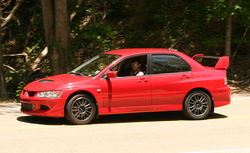
Production January 2003 – March 2005
(February 2004 – August 2006 MR)Platform CT9A Transmission 5-speed manual
6-speed manualWheelbase 2,625 mm (103.3 in) Length 4,490–4,535 mm (176.8–178.5 in) Width 1,770 mm (69.7 in) Height 1,450 mm (57.1 in) Curb weight 1,320–1,410 kg (2,910–3,109 lb) The Evolution VIII was modified again in 2003, this time sporting 17" grey Enkei wheels, Brembo Brakes and Bilstein shocks to handle traction and a 5-speed manual gearbox with 280 PS (202 kW; 276 hp)(approx. 234hp to the wheels). Originally a one off model, sales were so successful in the U.S. that by 2005 it was available in four trims: the standard GSR model in Japan, the RS, with an aluminum roof, 5-speed gearbox, and standard wheels (lacking excess components, such as interior map lights, power windows/doors, and radio), the SSL (with a sunroof, trunk mounted subwoofer, and leather seats), and the MR, which came with a revised limited-slip front differential, aluminum MR shift knob, handbrake with carbon fiber handle, 17 inch BBS wheels, aluminum roof, and a 6-speed manual gearbox. The new Evolution also sported chrome housing tail lights and head lights.
The Lancer Evolution VIII MR uses slick-response Bilstein shocks for improved handling. The aluminium roof panel and other reductions in body weight have lowered the centre of gravity to produce more natural roll characteristics. Detail improvements have also been made to Mitsubishi’s own electronic four-wheel drive, to the ACD 5 + Super AYC 6 traction control, and to the Sports ABS systems. The Lancer Evolution VIII displayed at the 2003 Tokyo Motor Show took the MR designation traditionally reserved for Mitsubishi Motors high-performance models (first used for the Galant GTO). Other parts on the MR include BBS alloy wheels, the aforementioned Bilstein shocks, and an aluminium roof. In the United Kingdom, many special Evolutions were introduced, including the FQ300, FQ320, FQ340, and FQ400 variants. They came with 305, 325, 345, and 405 hp (227, 239, 254 and 302 kW), respectively. Although Mitsubishi have not confirmed the fact, it is widely rumoured that the FQ stands for "Fucking Quick".[6][7][8]
The FQ400, sold through Ralliart UK, produces 411 PS (302 kW; 405 hp) from its 2.0 L 4G63 engine, the result of special modifications by United Kingdom tuning firms Rampage Tuning, Owen Developments, and Flow Race Engines. At 202.9 hp (151.3 kW) per litre, it has one of the highest specific outputs per litre of any roadcar engine. With a curb weight of 1,450 kg (3,197 lb), it achieves 0–60 mph in 3.0 seconds, 0–100 mph in 9.1 seconds, 1/4 mile in 10.9 seconds at 118 mph (190 km/h), and a top speed of 175 mph (282 km/h) while costing £47,000. BBC's television series Top Gear demonstrated that the stock FQ-400 could surprisingly keep up with a Lamborghini Murciélago around a test track. The Stig recorded a Top Gear Power Lap Times of 1 minute and 24.8 seconds, 1.1 seconds slower than the Murciélago's time of 1 minute 23.7 seconds.[9] In a similar test conducted by Evo magazine, the Evolution was able to lap the Bedford Autodrome faster than an Audi RS4 and a Porsche 911 Carrera 4S.
The Lancer Evolution VIII was also the first Evolution to be sold in the United States,[10] spurred by the success of the Subaru Impreza WRX which had been released there just three years prior.[3] The Evolution VIII found its true competition in the Subaru Impreza WRX STI model the same year as the Evolution VIII's US introduction. However, the internal components for the American versions were largely stripped-down versions of the specifications for the Japanese Lancer Evolution VIII. No US-spec Evolution model prior to the Evo X has active yaw control, including the 2006 Evolution IX. The American 2003 and 2004 GSRs are without the helical limited-slip front differential and 6-speed manual transmission. The 2004 US spec RS models, however, do have a front helical limited-slip differential. All 2003, 2004 and 2005 RS and GSR models have the Japanese Evolution VII's 5-speed transmission. The MR edition was introduced to the US in 2005, with ACD and the only model with a 6-speed transmission. The 2005 US spec RS and GSR have the ACD standard, and the front helical limited-slip differential is now standard on all models. The boost, timing, and tuning are also significantly lower than its Japanese counterpart, allowing it to adhere to the strict emissions regulations of the United States. Starting in 2005, the US model Evos were also fitted with a 5000rpm limit on launching in 1st gear to protect the drivetrain.
Most Evolution VIIIs have a carbon fiber rear spoiler with matching body-color endplates. Furthermore, the US versions of the Lancer Evolution VIII 2003–2005 were given bulkier rear bumpers than their Japanese counterparts to accommodate US safety laws in the form of the metal rear crash bar. All Evos have lightweight aluminum front fenders and hoods. MR and RS editions have an aluminum roof. Additionally, MR Editions come equipped with a 6-speed transmission, Bilstein shocks, and factory optional BBS wheels.
The basic RS Edition does not come with power windows, locks, or mirrors, an audio system, rear wing, sound deadening material, map lamps or an anti-lock braking system. All Evo VIII RS models sold in the US have an air conditioning system.[11]
The National Highway Traffic Safety Administration (NHTSA) has determined crash test ratings of Lancer of different model years[12]:
Model year Model Type Frontal driver rating Frontal passenger rating Side driver rating Side passenger rating 4x2 Rollover 2004 Lancer Evolution 4-DR N/A N/A 

N/A Evolution IX
Ninth generation Production March 2005 – October 2007(August 2006-Late 2008 MR) Platform CT9A Transmission 5-speed manual
6-speed manualWheelbase 2,625 mm (103.3 in) Length 4,490 mm (176.8 in) Width 1,770 mm (69.7 in) Height 1,450 mm (57.1 in) Curb weight 1,310–1,490 kg (2,888–3,285 lb) Mitsubishi introduced the Lancer Evolution IX in Japan on March 3, 2005,[13] and exhibited the car at the Geneva Motor Show for the European market the same day.[14] The North American markets saw the model exhibited at the New York International Auto Show the following month.[15] The 2.0 L Mitsubishi Sirius engine#4G63 engine has MIVEC technology (variable valve timing), and a revised turbocharger design boosting official power output at the crankshaft to 291 PS (214 kW; 287 hp) and torque to 392 N·m (289 lb·ft).
The USDM Lancer Evolution IX models: standard (Grand Sport Rally or "GSR" in some markets), RS (Rally Sport), SE (Special Edition) and MR (Mitsubishi Racing) varied slightly in their performance capabilities. Subtleties unique to each model accounted for variations in acceleration, handling and top speed. The RS excluded features standard on the standard, SE and MR models (stereo system, power windows and locks, rear wiper, rear wing, trunk lining and sound insulation). The result is a weight savings of over 60 lb (27 kg). The fuel capacity remains the same as the Evo VIII at 14 USgal (53 L).
Although the RS is the lightest of the group, the RS did not manage to outperform the standard IX and the MR around a road course (even if only by fractions of a second). This was purported to be due to the lack of a rear wing on the RS. In a drag race, the three models are all about even. The times for the quarter miles ranged from 12.4 to 12.7 seconds. The RS model was produced for rally and racing teams who wanted a platform to build a race car from. It is stripped of all the creature comforts, and other upgrades that drive the price up for features that the race teams would not require.
The IX MR retained the features of the Evolution VIII MR, like Bilstein shocks, a 6-speed manual transmission, a rooftop vortex generator, BBS forged wheels, HID xenon headlights, foglights, accessory gauge package, "zero lift" kit, special badging and an aluminum roof. All models continued to sport Recaro bucket seats, Brembo brakes and Momo steering wheels. Additional revisions from 2005 included a closer gear ratio for the 5-speed manual transmission, new lighter Enkei wheels on non-MR models, a redesigned front end with a more efficient air dam (the most noticeable feature are the two small oval ducts to cool the intercooler pipes), and a new rear bumper with a diffuser undersurface to smooth out the airflow coming out of the car for non-US models. In an effort to reduce the price increase on the Evolution IX model,[citation needed] HID headlights were no longer standard equipment on the base IX (nor were they standard on the 2005 VIII), and were available only in the SSL package (Sun, Sound, and Leather), SE (Special Edition) and MR trims.
The US versions of the Lancer Evolution IX did not come with the AYC but the ACD was still present. The drivers can select from three different driving modes, "Tarmac" "Gravel" and "Snow", and the car's computer system relatively promotes the active center differential to change the differential locking which, eventually changes the front/rear power distribution to increase traction, thus providing an optimum driving experience. Although the US versions did not come with the AYC, it did come with a rear 1.5way clutch type LSD (limited slip differential)which, limits the slip from both rear wheels causing less traction loss of the rear wheels. The most common setup is the 1.5 way LSD, locking on throttle and partially locking on braking. In racing, Lancer Evolutions are not equipped with AYC or ACD because it is believed that better lap times are achieved by pure driver skill without any computer based assistance systems.
One of the changes from the previous iteration of the Lancer Evolution, was the change in the engine, the new 4G63 came with MIVEC, Mitsubishi's variable valve lifting technology, which drastically improves the fuel consumption by changing the valve timing on the intake cam. The MIVEC system is similar to Honda's i-VTEC system only that it doesn't change valve lift, only intake valve timing.
Three trims were available for Japan, Asia and Europe. Although all models used the same 291 PS (214 kW; 287 hp) engine, the torque differed from one model to another. In Europe, however, the Evolution IX was advertised to have 280 PS (206 kW; 276 hp). The GSR produced 400 N·m (295 lb·ft) of torque, while the RS and GT produced 407 N·m (300 lb·ft).
- RS – "rally sport", revised 5-speed, aluminium roof, gauge pack, minimal interior, LSD and a titanium-magnesium turbine, left-hand drive option available.
- MR RS – same as RS with 6-speed Manual Transmission.
- GT – revised 5-speed, this is basically the RS mechanically, but with some of the GSR's features (mainly interior pieces).
- GSR – 6-speed, Bilstein monotube shocks, aluminium roof, gauge pack, SAYC (Super Active Yaw Control), and double-din radio (this is roughly equivalent to the USDM MR).
- MR GSR – same as GSR with BBS 17-inch alloy wheels.
- MR Tuned by RALLIART – Based on Lancer Evolution VI Tommi Makinen Edition, The Japanese Lancer Evolution IX was exclusively tuned by Mitsubishi Ralliart features the almost same as the civilian Evo IX MR GSR except for Carbon Fiber front lip Spoiler, Official Ralliart livery, Ralliart RA04 17-inch Black forged aluminum wheels.
In the United Kingdom, the Evolution IX used a different model scheme based on the car's horsepower. There were initially three models available: the FQ-300, FQ-320 and FQ-340 each with around 300(296/221), 320(316/236) and 340(336/250) PS(BHP/KW) respectively. An FQ-360 model was subsequently released as a successor to the Evolution VIII FQ-400. While the new FQ-360 produced less horsepower than its predecessor, it had more torque at 363 lb·ft (492 N·m) at 3200 rpm. All four models were designed to run on super unleaded petrol only. The MR FQ-360 was also released in limited numbers (only 200) in the last year of production.
- FQ-300, 320, 340 – 6-speed, Bilstein monotube shocks, AYC (Active Yaw Control), super unleaded petrol only
- FQ-360 – 6-speed, Bilstein monotube shocks, AYC (Active Yaw Control), Ralliart Sports Meter Kit, carbon front splitter, Speedline alloy wheels, super unleaded petrol only
- MR FQ-360 – New turbo with titanium aluminium alloy turbo fins, Speedline Turini alloy wheels, Privacy Glass, Lowered Eibach Coil springs (10mm at the front/ 5mm at the rear), IX MR interior, super unleaded petrol only
Four models were available in the US. All models used the same 286 hp (213 kW) engine.
- Standard – revised 5-speed, standard model
- RS – ralli sport, revised 5-speed, aluminum roof, gauge pack, minimal interior, also no radio
- SE – Special Edition, aluminum roof/hood, and front fenders, split seven-spoke forged aluminum BBS wheels in "diamond black" finish, HID headlights with integrated fog lights, red-stitched Recaro seats
- MR – 6-speed, Bilstein monotube shocks, split seven-spoke forged aluminum BBS wheels, aluminum roof, hood, and front fenders, gauge pack, HID headlights with integrated fog lights, vortex generator, front brake cooling ducts and custom MR badging.
All of the American models are the same in power, but may differ in performance. The only thing that sets them apart is the Evo RS, which is 80 lb (36 kg) lighter than the MR and SE models.
To the standard model, the Sun, Sound and Leather package added a power sunroof, HID xenon headlamps with integrated fog lights, a slightly different stereo headunit (with no integral amplifier), slightly upgraded speakers in the front doors and parcel shelf, a 4.1-channel amplifier under the driver's seat, a powered, trunk-mounted Infinity subwoofer, black leather seating surfaces, leather-trimmed door panels, slightly revised center armrests in the front and rear, and separate rear side headrests. This model deleted the GSR's headliner-mounted sunglass holder to make room for the sunroof.
The Philippines had the Evolution IX until in August 2008, which was offered in two trims, the entry-level RS offering a 5-speed manual transmission, Brembo 17-in. ventilated discs (4-Pot), Brembo 16-in ventilated drum-in-disc (2-Pot) and almost the same features as to that of the GSR trim in the international version. Some RS models had the SAYC option, while some did not. The MR was the top-of-the-line segment, which offers almost the same feature as to that of the MR trim in the international version. All of them are powered by a l4 2.0 4G63 turbocharged MIVEC engine.
Evolution X
Tenth Generation 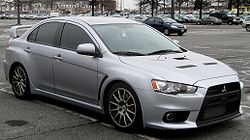
Production October 2007 – 2013 Platform CZ4A Transmission 6-speed twin-clutch transmission
5-speed manualWheelbase 2,650 mm (104 in) Length 4,495 mm (177.0 in) Width 1,810 mm (71 in) Height 1,480 mm (58 in) Curb weight 1,420–1,600 kg (3,131–3,527 lb) In 2005, Mitsubishi introduced a concept version of the next-gen Evolution at the 39th Tokyo Motor Show named the Concept-X,[16] designed by Omer Halilhodžić at the company's European design centre.[17]
Mitsubishi unveiled a second concept car, the Prototype-X, at the 2007 North American International Auto Show (NAIAS).[18]
The Lancer Evolution X sedan features a newly designed 4B11T 2.0L (1998cc) twin turbocharged, all-aluminium inline-4 GEMA engine. Power and torque depend on the market but all versions will have at least 280 PS (206 kW; 276 hp). (JDM version), the American market version will have slightly more. The UK models will be reworked by Mitsubishi UK, in accordance with previous MR Evolutions bearing the FQ badge. Options for the UK Evolutions are expected to be between 300 hp (220 kW) and 360 hp (270 kW).
Two versions of the car will be offered in the U.S. The Lancer Evolution MR, with 6-speed Twin Clutch Sportronic Shift Transmission (TC-SST). The other version is the GSR which will have a 5-speed manual transmission system. The car also has a new full-time four-wheel drive system named S-AWC (Super All Wheel Control), an advanced version of Mitsubishi's AWC system used in previous generations.[19] The S-AWC uses torque vectoring technology to send different amount of torque to any wheel at any given time.
It also features Mitsubishi's new sequential semi-automatic six speed SST twin-clutch transmission with steering-mounted magnesium alloy shift paddles. It has replaced the Tiptronic automatic transmission, hence the SST version replaced the GT-A version (which was used in Evolution VII and Evolution IX Wagon). A five speed manual gearbox will also be available. Mitsubishi claims that the five speed manual transmission has always been preferred in rallying and should be very refined, resulting in a more satisfying drive.[20] New Lancer Evolution will incorporate Mitsubishi's next generation RISE safety body.
The Evolution X went on sale October 1, 2007 in Japan,[21] January 2008 in the USA,[22] February in Canada (as the first version of Evolution in Canada)[23] and in March 2008 in the UK.[24] The Twin Clutch SST version was available in Japan from November 2007.[25] Europe will follow with sales in May, GSR and MR version included premium Package.
The introduction of the 2010 MR-Touring moved the car even further upscale. Leather and a Moonroof became standard while revising the rear spoiler to just a lip spoiler.
Japanese models
The engine is the 4B11-type 2.0 litre inline-4 twin turbo engine. The Evolution X can accelerate from 0–100 km/h in 4.8 seconds. Aluminum is used in the roof panel, front fenders and the rear spoiler frame structure.[26] The launch model's engine was rated at 280 PS (206 kW; 276 hp) @ 6500 rpm and 422 N·m (311 lb·ft) @ 3500 rpm. Following the repeal of the 276 horsepower Gentleman's Agreement in Japan,[27] engine power was raised to 300 PS (221 kW; 296 hp) @ 6500 rpm beginning in 2009 model year.
- RS – 5 speed manual transmission. 16-inch wheels.
- GSR – Standard rear spoiler. 5-speed manual or 6-speed Twin Clutch SST transmission (magnesium paddle shifters on SST model). 245/40R18 Yokohama ADVAN A13C tire on Enkei 12-spoke high-rigidity cast alloy wheels or optional BBS lightweight alloy wheels. Brembo ventilated disc brakes. Standard S-AWC 4WD system. Driver and front passenger dual-stage airbag. Standard Engine immobilizer with security alarm. Optional Mitsubishi Motors Communication System (MMCS) which comprises a 30Gb hard disk drive audio/navigation system with 7 in (180 mm) LCD screen. Optional Rockford Fosgate premium sound system. Optional keyless remote entry.
GSR can be fitted with following packages:
- High Performance Package – Bilstein single tube shock absorbers and Eibach coil springs, brembo 2-piece disc brakes, high performance tires with stiffer walls and better grip.
- Stylish Exterior Package – Chrome finish for the front grille lattice and beltline molding, body color-keyed fender vents, adds fog lamps.
- Leather Combination Interior – The seats match the color of the exterior.
- Premium Package – All 3 above packages plus 18 in (457 mm) BBS lightweight alloy wheels.
- GSR-Premium – Replacement of Premium Package beginning with 2009 model year, but added MMCS and Rockford Fosgate premium audio.
- GSR Tuned by RALLIART – The Ralliart version was launched again in 2007, this limited edition for Lancer Evolution X is exclusively tuned by Mitsubishi Ralliart Japan equipped with 5 speed manual transmission, Ralliart RA04 Wheels 18 inch forged 1-piece black aluminum sport wheels paired with Yokohama ADVAN Neova AD08 tires. Aerodynamic parts include a newly designed carbon fiber front underspoiler, hood air dam, and front bumper air intake duct, and the intake and exhaust system has been tuned to get the best out of the engine. The interior is fitted with a motor sport shell-type full bucket seat jointly developed with Recaro. Official Ralliart livery was included in the packege together with Rockford Fosgate premium sound system with Mitsubishi Motors Communication System (MMCS) which comprises a 30Gb hard disk drive audio/navigation system with 7 in (180 mm) LCD screen. Its highly tuned 4B11T engine has maximum power output of 224 KW (300 bhp/ 304 ps) or more.[28]
North American models
Engine produces 295 PS (217 kW; 291 hp) @ 6500 rpm and 407 N·m (300 lb·ft) @ 4400 rpm.
- GSR – Same as base Japanese GSR with small spoiler. (available only with manual 5 speed)
- MR – 6-speed TC-SST transmission. Suspension with Eibach springs and Bilstein struts. 18-inch BBS forged alloy wheels. Xenon High-Intensity Discharge (HID) headlamps. Color-keyed large rear spoiler. Leather and sueded seating. Electronic keyless entry and starting system. Steering wheel-mounted audio controls. Bluetooth hands-free cellular phone interface system with voice recognition.
- MR Premium – MR with a Rockford Fosgate Navigation/Stereo with 9 speakers.[29]
- MR Touring – (2010) Major differences from the MR are the rear-lip spoiler, heated full-leather seats, upgraded interior trim, and a power-sunroof on a steel roof.
- SE – (late 2010–11) Is a combination of all three 2010 models; some key features are the GSR front grill and interior, MR rear diffusers, 6-speed TC-SST transmission, Eibach springs and Bilstein struts, MR touring rear-lip spoiler, and heated seats. Only 340 were produced in the United States. A special key fob with the series number and a letter of acknowledgement from Shin Kurihara were given to the purchaser of this trim.
Option packages:
- (GSR only) Sight, Sound and Spoiler Package – Xenon HID headlamps with manual leveling; large rear spoiler (starting in 2011, the large rear spoiler is standard in all models); FAST-Key electronic entry and starting system; 650-watt (maximum) Rockford Fosgate audio system; in-dash 6-disc CD changer; Sirius Satellite Radio with six months prepaid subscription.
- (MR and MR Touring) Technology Package: Mitsubishi Multi Communication System, GPS navigation with Diamond Lane Guidance; 30GB hard disc drive with Digital Music Server, in-dash DVD/CD player, multifunction 7-inch (180 mm) color LCD touchscreen, 650(710 for 2010 model)-watt (maximum) Rockford Fosgate high-performance audio system, Sirius Satellite Radio with six months prepaid subscription.
UK models
UK cars kept the Evolution X name.
- GS – Base Japanese GSR with Enkei wheels, 5-speed manual transmission\ radio and music server (MMCS), Rockford Fosgate premium audio, iPod/MP3 auxiliary input port.
- GSR SST (FQ-300, FQ-330) – GSR FQ-300 with 6-speed TC-SST transmission with SST mode selection (normal, sport, super sport). GSR SST FQ-330 was released in 2009.[30]
Variants:
- FQ-300 – Engine rated 300 PS (220 kW; 300 hp) at 6500 rpm and 407 N·m (300 lb·ft) at 3500 rpm.
- FQ-330 – Engine rated 329 PS (242 kW; 324 hp) at 6500 rpm and 437 N·m (322 lb·ft) at 3500 rpm.
- FQ-360 – Engine rated 359 PS (264 kW; 354 hp) at 6500 rpm and 492 N·m (363 lb·ft) at 3500 rpm. Carbon fibre front lip spoiler, rear vortex generator, gear knob, hand brake. Front leather Recaro seats.
- FQ-400 – Engine rated 410 PS (300 kW; 400 hp) and 542 N·m (400 lb·ft) of torque. It also includes 5 speed manual transmission, six-piston brake calipers, upgraded brakes and 18-inch wheels fitted with Toyo Proxes R1R tyres, a new aero kit that includes additional cooling intakes, vents, a larger air intake in the hood and ducts. An estimated 100 vehicles would be made.[31] It accelerates 0–62 mph in 3.8 seconds (est.) and has a top speed of 155 mph (electronically limited).
Standard equipment for the range-topping Lancer Evolution X model is comprehensive, the FQ-400 coming with Bluetooth hands-free telephone connection, a CD-tuner with 30 Gig hard drive, DVD satellite navigation and privacy glass. Convenience features like remote central locking, automatic headlamps and windscreen wipers increase the FQ-400’s ease of use. Available from June 2009, the FQ-400 is covered by a three year / 36,000 mile warranty. Cost £49,999 (list price).[32]
European models
Acceleration: 0–100 km/h 5.4 sec. with 1560 kg, 5.6 sec. with 1600 kg. Engine rated 295 PS (217 kW; 291 hp) at 6500 rpm and 366 N·m (270 lb·ft) at 3500 rpm.
- GSR – 5 speed manual (GSR 5 M/T) or 6-speed TC-SST transmission (GSR TC-SST).
- MR TC-SST – 6-speed TC-SST transmission. Suspension with Eibach springs and Bilstein struts. 18-inch BBS forged alloy wheels. Xenon High-Intensity Discharge (HID) headlamps. Mitsubishi Multi Communication System.
Australian / New Zealand models
Engine rated 295 PS (217 kW; 291 hp) at 6500 rpm and 366 N·m (270 lb·ft) at 3500 rpm.
- GSR – 5 speed manual or 6-speed TC-SST transmission.
- MR – 6-speed TC-SST transmission. Suspension with Eibach springs and Bilstein struts. 18-inch BBS forged alloy wheels, 2 piece front brake, aluminium rear spoiler, auto leveling Xenon High-Intensity Discharge (HID) headlamps. Mitsubishi Multi Communication System, leather combination seat trim, heated front seats.
- Bathurst Edition – A factory upgraded/tuned version Evolution X with a rated power output of 336 PS (247 kW) and 436 Nm of torque. The Team Mitsubishi Ralliart (TMR) Bathurst Edition is the most powerful road-legal Lancer Evolution X to be offered in Australia. The Bathurst edition is available with either the standard 5-speed manual or the quick-shifting TC-SST twin-clutch automatic with a limited run of only 500 units.
Southeast Asian models
Philippine models
The Philippines received its Evolution X in November 2008, and is a CBU from the US. The trims and specs are almost the same, excluding the MR Touring model from the USDM.
- GSR- 5-speed manual, and the same specs with the USDM GSR with large spoiler.
- MR- 6-speed TC-SST gearbox, and the same specs with the USDM MR, excluding the Technology Package.
Malaysian models
In Malaysia, the Lancer Evolution X is available with only a 6-speed Twin Clutch SST transmission. Front license plates are aligned towards the center of the fascia. In 2009, the Royal Malaysian Police acquired a fleet of Lancer Evolution Xs to be used for high-speed pursuits.
Future
Rumours of discontinuation of the Lancer Evolution program started when AutoCar UK's journalist Matt Prior wrote on his interview with Gayu Eusegi, Mitsubishi’s Global Product Director, and quoted him saying "The Lancer Evolution X, Eusegi told me, will be the last Evo. “There is still a demand [for the car],” he said, “but we must stop.” Eyebrow up."[33] This created a lot of discussion on the Internet. Mitsubishi Motors Canada would later issue a statement on its official Facebook page, saying "Further to some comments published in the press recently, production of the current Lancer Evolution continues as planned. As for its successor, regulations and market feedback will dictate its engineering package & architecture. Stay tuned.." Industry analysts would read the statement as indirectly hinting that the Evolution nameplate will remain, but is likely to be a environmentally friendly powertrain (possibly electric or hybrid), inline with increasingly stringent emission and environmental regulations. AutoCar UK later updated its blog post, adding references to EV, further confirming what industry watchers originally speculated. Most recent news shows that Mitsubishi has been leaning towards the PX-MIEV hybrid drivetrain, explaining that the electric motors will act as a turbo for the Evolution. Mitsubishi claims that their more "green" version of the Evolution will be just as good or even better in the performance category, however this is highly doubtful.
Motorsports
The Lancer Evolution is unique among its competitors in the World Rally Championship in that it was a homologated Group A car slightly modified to be able to race competitively against, from the 1997 season onwards until the San Remo Rally in 2001, World Rally Car class cars. They were successful in the WRC Rallies from 1996–1999,thanks to the Finn Tommi Mäkinen, for clinching the driver's titles from 1996–1999, and the help of teammate Richard Burns for clinching the constructors' championship for the first, and thus far only time in 1998. The Evolution however was replaced in late 2001 by the firm's first World Rally Car, named simply the Lancer Evolution WRC, which lasted in works hands, driven by Makinen, Freddy Loix, Alister McRae and Francois Delecour until Mitsubishi took a sabbatical from the championship at the end of 2002. It was succeeded for the 2004 Monte Carlo Rally by the Lancer WRC04. Mitsubishi pulled out of the World Rally Championship after the 2005 season with the Lancer WRC05 still being driven by privateers including Italian former works driver Gigi Galli and the Swede, Daniel Carlsson, in the years following. The Lancer Evolution however still competes in the Group N category.
In some European markets, the Evolution was sold as the Mitsubishi Carisma Evolution, and indeed to this effect the works WRC team's second car in the late 1990s, usually driven by Burns and subsequently Loix, was customarily entered as a Carisma GT. Proton Motors of Malaysia raced Evolution III's, Evolution V's (most notable with Proton 1784 where Malaysian driver Karamjit Singh won the 2002 Production Car WRC) and an Evolution VII as the Proton PERT in various Asia-Pacific Rally Championship and APAC rally series.
Mitsubishi won the 2009 Australian Manufacturers' Championship with a trio of Evolution X models.
Most recently, (2009-2011) the CT9A chassis Evolution has been dominant in Time Attack (time trials) throughout the world. Cyber Evo's CT9A chassis Lancer Evolution holds the OEM chassis record at Japan's Tsukuba Circuit for Time Attack, as well as the Australian record at Eastern Creek Raceway. Sierra Sierra Enterprise's CT9A chassis Evolution holds the U.S. Time Attack record.
Awards
The Mitsubishi Lancer Evolution won ConsumerSearch's best Aggressive sports sedan in Best Sports Sedans in June 2006.[34] During 2004–2005 alone it won six major awards, being declared "Sports Car of the Year" in Scotland and France, "Playboy Sports Car 2004" in Poland, "Best New Production Car Under €60,000" in Greece, "Sport Compact Car of the Year" in 2004 and 2005 (Sport Compact Car magazine) and "2005 All-Star" (Automobile magazine) in the United States and Motor magazine's Best "Bang for Your Bucks" Australia.[35] The Lancer Evolution X was named as the "Best Performance Car under $50K" by Canadian TV show Motoring 2009, and won the Automobile Journalists Association of Canada's 2009 "Best New Technology" award.[36] It was also nominated as one of the top 10 "World Performance Car of the Year",[37] won the Automotive Excellence Awards' 2008 "Fun to Drive" category,[38] and took Dave TV's "Sports Car of the Year" award in 2008.[39]
See also
References
- ^ Long, Brian (2007). Mitsubishi Lancer Evo: The Road Car & WRC Story. Dorchester: Veloce Publishing Ltd. ISBN 1-84584-055-0. http://books.google.co.uk/books?id=8ZkuDYyI8NUC.
- ^ "Development of Center-Differential Control System for High Performance Four-Wheel Drive Vehicles", Mitsubishi Motors Technology Review 2001, no.13, pp.61–66
- ^ a b "2003 Mitsubishi Lancer Evolution", Michael Frank , Forbes
- ^ http://www.lancerregister.com/mlr_showmodel.php?id1=6&id2=4
- ^ "Lancer Evolution III" (PDF). http://www.mitsubishimotors.com/media/evo/EVO%20Heritage_3.pdf. Retrieved December 19, 2009.
- ^ "EVO VII FQ-300", Graham Bell, Pistonheads, October 17, 2002
- ^ "Mitsubishi Evo FQ-360", ShaunCurnow, Redline Magazine, July 19, 2006
- ^ "Mitsubishi Evo VIII", Jeremy Clarkson, The Times, July 25, 2004
- ^ "Top Gear – Power Laps". BBC. October 20, 2008. http://www.bbc.co.uk/topgear/show/powerlaps.shtml. Retrieved October 7, 2010.
- ^ "Mitsubishi Lancer Evolution for U.S. Market Debuts at 2003 Greater Los Angeles Auto Show; Mitsubishi's Expanding Motor Sports Program to Dominate in 2003; Ralliart Comes to U.S.; and Mitsubishi Goes 'Fast and Furious' Too.", PR Newswire, January 3, 2003
- ^ "2004 Mitsubishi Lancer Evolution RS: A Race-Ready Rally Car"[dead link], Mitsubishi Motors Press Release, November 4, 2003
- ^ "1990–2010 Search Results by Model". NHTSA.GOV. http://www.safercar.gov/Vehicle+Shoppers/5-Star+Safety+Ratings/1990-2010+Vehicles/Search-Results?searchtype=model&make=MITSUBISHI&model=LANCER+EVOLUTION&year=. Retrieved March 17, 2011.
- ^ "Mitsubishi Motors launches Lancer Evolution IX hi-performance 4WD sports sedan", Mitsubishi Motors press release, March 2, 2005
- ^ "Mitsubishi Lineup at 75th Geneva International Motor Show", Mitsubishi Motors press release, March 1, 2005
- ^ "2005 New York Auto Show", Automobilemag.com
- ^ "Mitsubishi Motors Exhibits at 39th Tokyo Motor Show", Mitsubishi Motors press release, September 28, 2005
- ^ "Mitsubishi Concept-X Exterior Design Story", Mitsubishi Motors Technology Review 2006, no.18, pp.134–135
- ^ "2007 North American International Auto Show – Vehicle Introductions". NAIAS. 2007. Archived from the original on January 6, 2007. http://web.archive.org/web/20070106205244/http://www.naias.com/SubPage.aspx?id=506. Retrieved January 10, 2007.
- ^ "2007 Mitsubishi Prototype X Concept". Carpages.ca. 2007. http://www.carpages.ca/go/conceptcars/2007_mitsubishi_prototype_x_concept.aspx. Retrieved March 21, 2007.
- ^ "Evolution X to get double-clutch gearbox", John Neff, Autoblog.com, August 23, 2005
- ^ "MMC launches Lancer Evolution X – new-generation high-performance 4WD sedan", Mitsubishi Motors press release, October 1, 2007
- ^ "View from Japan – 2008 Mitsubishi Lancer Evolution X". autoweek.com. 2007. http://www.autoweek.com/apps/pbcs.dll/article?AID=/20070928/FREE/309280001/1065. Retrieved October 1, 2007.
- ^ "2007 Mitsubishi Lancer Evolution". wheels.ca. March 2003. http://www.wheels.ca/article/19747. Retrieved October 28, 2007.
- ^ "Mitsubishi Evo X First Drives". carmagazine.co.uk. 2007. http://www.carmagazine.co.uk/print.php?sid=1098. Retrieved October 1, 2007.[dead link]
- ^ "Officially Official: Mitsubishi Lancer Evolution X". autoblog. October 1, 2007. http://www.autoblog.com/2007/10/01/officially-official-mitsubishi-lancer-evolution-x/. Retrieved October 1, 2007.
- ^ "MMC launches Lancer Evolution X – new-generation high-performance 4WD sedan". Media.mitsubishi-motors.com. October 1, 2007. http://media.mitsubishi-motors.com/pressrelease/e/products/detail1682.html. Retrieved October 7, 2010.
- ^ "Why Japan finally got its foot off the brake". Japan Times. April 13, 2008. http://search.japantimes.co.jp/cgi-bin/fv20080413pl.html. Retrieved October 7, 2010.
- ^ [http://www.ralliart.com/07topics/07002.html "Mitsubishi Motors/RALLIART Exhibiting 2 Cars: Lancer Evolution X tuned by RALLIART and Group N Rally Car at Tokyo Auto Salon 2008 with NAPAC"]. Ralliart.com. December 20, 2007. http://www.ralliart.com/07topics/07002.html. Retrieved December 20, 2007.
- ^ "Mitsubishi announces pricing for long awaited Lancer Evolution". Lancerevolution.ca. January 21, 2008. http://lancerevolution.ca/archive/35/mitsubishi-announces-competitive-pricing-for-long-awaited-lancer-evolution/. Retrieved October 7, 2010.
- ^ Lavrinc, Damon (May 20, 2009). "Euro-only: Mitsubishi Evolution FQ-330 SST". Autoblog.com. http://www.autoblog.com/2009/05/20/euro-only-mitsubishi-evolution-fq-330-sst/. Retrieved October 7, 2010.
- ^ Lavrinc, Damon (December 1, 2008). "Mitsubishi Evolution X FQ400 coming with 405 hp". Autoblog.com. http://www.autoblog.com/2008/12/01/mitsubishi-evolution-x-fq400-coming-with-405-hp/. Retrieved October 7, 2010.
- ^ "Mitsubishi Lancer Evolution FQ-400 – the fastest lancer ever released". Inautonews.com. http://www.inautonews.com/mitsubishi-lancer-evolution-fq-400-the-fastest-lancer-evolution-ever-released. Retrieved October 7, 2010.
- ^ "Mitsubishi to ditch the Evo for EVs". http://www.autocar.co.uk/blogs/autocarconfidential/archive/2011/03/01/the-mitsubishi-evo-is-no-more.aspx.
- ^ "ConsumerSearch's Best Sports Sedans Reviews". Consumersearch.com. http://www.consumersearch.com/www/automotive/sports-sedans/index.html. Retrieved October 7, 2010.
- ^ Fact & Figures 2005, p.31, Mitsubishi Motors website
- ^ "Mitsubishi Motors Canada Website". Mitsubishi-motors.ca. http://www.mitsubishi-motors.ca/Lancer_Evolution/Awards.aspx. Retrieved October 7, 2010.[dead link]
- ^ "World Car of The Year Awards". Wcoty.com. http://www.wcoty.com/media/?release=49&year=2009. Retrieved October 7, 2010.
- ^ "Popular Mechanics". Popular Mechanics. October 1, 2009. http://www.popularmechanics.com/automotive/new_cars/4230193.html. Retrieved October 7, 2010.
- ^ "Mitsubishi Lancer Evo X takes Dave TV’s “2008 Sports Car of the Year” award", 4wheelsnews.com, November 18, 2008
External links
- Official sites: Japan · Australia · Europe · United Kingdom · United States
Mitsubishi Motors North America timeline Type 1980s 1990s 2000s 2010s 0 1 2 3 4 5 6 7 8 9 0 1 2 3 4 5 6 7 8 9 0 1 2 3 4 5 6 7 8 9 0 1 Subcompact Cordia Tredia Mirage Mirage Mirage Precis Compact Mirage Lancer Lancer Galant Galant Sigma Galant Diamante Sport compact Eclipse Eclipse Eclipse Eclipse Lancer Evolution Lancer Evolution Mid-size Galant Galant Diamante Diamante Sports car Starion 3000GT Station wagon Space Wagon Expo Expo LRV Compact XUV Outlander Outlander Outlander Sport/RVR Mid-size XUV Endeavor Minivan Vanwagon Sport utility vehicle Montero Sport Montero Montero Montero Pickup Mighty Max Mighty Max Raider L200 Categories:- All wheel drive vehicles
- Mitsubishi Motors vehicles
- Sports sedans
- Sport compact cars
- Rally cars
- 1990s automobiles
- 2000s automobiles
- 2010s automobiles
- Vehicles introduced in 1992
Wikimedia Foundation. 2010.

